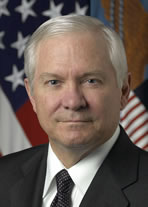
Cutting over $100 billion in U.S. defense spending in the next five years could be an opportunity to turn the Defense Department into a leaner, more efficient organization, eliminating fat, dust and rust that developed through the system in decades. At least this is what Defense Secretary Robert Gates is hoping for, however, as Gates will leave office soon, someone else will have to bring this hope into reality.
Bowing under budget pressure across all government levels, the Defense department, intelligence and military services are called to share this effort, mainly through streamlining operational logistics and support, shedding unnecessary positions, improving information and communications systems through modern enterprise networks, and eliminating redundant command levels that are not suitable for today’s operations.
The Air Force was asked to save about $34 billion, the Navy $35 billion and the Army will share $28 billion of the saving costs. 0f 70% of these cuts will be reinvested in procurement of new equipment, modernization and reset of existing systems and new development programs.
Sharing the Burden
The Air Force plans to saving its share by consolidating two air operations centers in the U.S. and two in Europe, reducing fuel consumption within the Air Mobility Command, improving supply chain and business processes at depots centers and reducing the cost of communications infrastructure are parts of these measures.
The Army proposes eliminating over 1,000 civilian and military positions, and consolidating six installation management commands into four, saving billions in construction costs and sustainment. Consolidation of the service’s email infrastructure and data centers is also planned.
The Navy plans reducing manpower ashore and reassigning 6,000 personnel to operational missions at sea; shifting new airborne surveillance, jamming, and fighter aircraft procurement to multi-year programs that could yield $1.3 billion in saving and disestablishing staffs for submarine, patrol aircraft, and the destroyer-squadrons plus one carrier strike group staff. The Navy also proposes to disestablish the headquarters of Second Fleet in Norfolk. During the Cold War, this command had distinct and significant operational responsibilities. Today its primary responsibility is training and mission preparation, a function that will be transferred to the Navy’s Fleet Forces Command. This change would affect approximately 160 military positions. And no ships will depart Norfolk as a result.
Trimming at the Top
Cuts will also affect the highest level of command at the Joint Staff and DoD, eliminating 11% of the current 900 general officer and flag officer positions. Some of these positions were created in the past decade to support the wars in Iraq and Afghanistan, and will be reduced as major troop deployments wind down. Other positions will be downgraded to save costs and streamline command structures, along with 200 civilian Senior Executive Service or equivalent positions out of a total of 1,400 civilian executives. Gates said that the primary purpose behind this shift is to create fewer, flatter, more agile, and thus more effective organizations. These commands will be reduced to the three star-level, with concurrent streamlining in the headquarters and personal staff. The change to U.S. Navy Europe will take place over a longer period because of that command’s unique role in the NATO transformation effort.
Gates said that the proposed elimination of the Norfolk based Joint Forces Command has been reviewed, and according to Gates, a number of missions should be retained in the Norfolk/Suffolk, Virginia area, while roughly half of the command’s capabilities will be assigned to other organizations.
The DoD-wide freeze on the number of civilian positions and government-wide freeze on civilian salaries has yielded about $54 billion in additional savings over the next five years. “Overall, we will cut the size of the staff support contractor cadre by 10 percent per year for three years and realize nearly $6 billion in total savings.” gates said during a briefing at the Pentagon today.
Reshuffling Intelligence Responsibilities
Following comprehensive review of national intelligence services DOD Intelligence services will also experience downsizing and budget cuts for the first time since 9/11. The U.S. government as a whole has seen a proliferation of new intelligence organizations, many that are excess and duplicative, many that are spread out among the different services, agencies, task forces of various kinds, and combatant commands. Gates emphasized that the proposed cuts will downsize the new intelligence organizations that have grown up around a number of the combatant commands in recent years – most of which are not directly engaged in the post-9/11 military conflicts. “In place of having a large, permanent organic apparatus staffed on a wartime level, the department will transition to an arrangement that can surge intelligence support as needed from the Defense Intelligence Agency (DIA).” Gates explained. The department is also proposing to consolidate activities of multiple intelligence organizations operating under different commands and focusing on counter-terrorism and terrorism finance. These activities will consolidate into two task forces operated within DIA.
Introducing Enterprise IT Infrastructure
DOD spends over $37 billion each year on information technology. Each service runs an independent “our bases and headquarters have their own separate IT infrastructure and processes, which drive up costs and create cyber vulnerabilities” Gates explained “the department is planning to consolidate hundreds of data centers and move to a more secure enterprise system, which we estimate could save more than $1 billion a year.

















